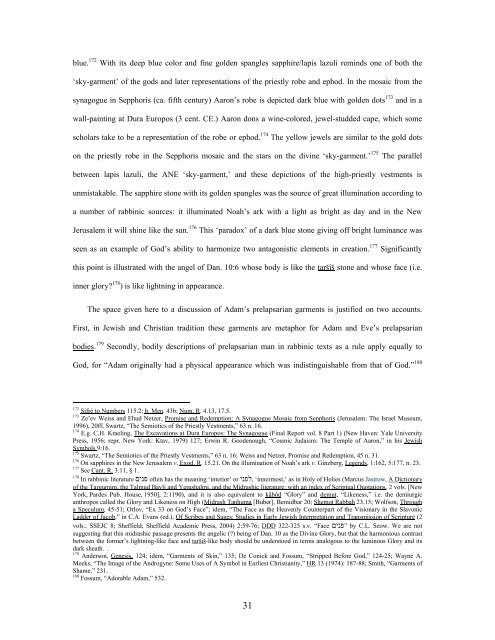Sapphiric God: - Dr. Wesley Muhammad
Sapphiric God: - Dr. Wesley Muhammad
Sapphiric God: - Dr. Wesley Muhammad
Create successful ePaper yourself
Turn your PDF publications into a flip-book with our unique Google optimized e-Paper software.
lue. 172 With its deep blue color and fine golden spangles sapphire/lapis lazuli reminds one of both the<br />
‘sky-garment’ of the gods and later representations of the priestly robe and ephod. In the mosaic from the<br />
synagogue in Sepphoris (ca. fifth century) Aaron’s robe is depicted dark blue with golden dots 173 and in a<br />
wall-painting at Dura Europos (3 cent. CE.) Aaron dons a wine-colored, jewel-studded cape, which some<br />
scholars take to be a representation of the robe or ephod. 174 The yellow jewels are similar to the gold dots<br />
on the priestly robe in the Sepphoris mosaic and the stars on the divine ‘sky-garment.’ 175 The parallel<br />
between lapis lazuli, the ANE ‘sky-garment,’ and these depictions of the high-priestly vestments is<br />
unmistakable. The sapphire stone with its golden spangles was the source of great illumination according to<br />
a number of rabbinic sources: it illuminated Noah’s ark with a light as bright as day and in the New<br />
Jerusalem it will shine like the sun. 176 This ‘paradox’ of a dark blue stone giving off bright luminance was<br />
seen as an example of <strong>God</strong>’s ability to harmonize two antagonistic elements in creation. 177 Significantly<br />
this point is illustrated with the angel of Dan. 10:6 whose body is like the taršîš stone and whose face (i.e.<br />
inner glory? 178 ) is like lightning in appearance.<br />
The space given here to a discussion of Adam’s prelapsarian garments is justified on two accounts.<br />
First, in Jewish and Christian tradition these garments are metaphor for Adam and Eve’s prelapsarian<br />
bodies. 179 Secondly, bodily descriptions of prelapsarian man in rabbinic texts as a rule apply equally to<br />
<strong>God</strong>, for “Adam originally had a physical appearance which was indistinguishable from that of <strong>God</strong>.” 180<br />
172<br />
Sifré to Numbers 115.2; b. Men. 43b; Num. R. 4.13, 17.5.<br />
173<br />
Ze’ev Weiss and Ehud Netzer, Promise and Redemption: A Synagogue Mosaic from Sepphoris (Jerusalem: The Israel Museum,<br />
1996), 20ff; Swartz, “The Semiotics of the Priestly Vestments,” 63 n. 16.<br />
174<br />
E.g. C.H. Kraeling, The Excavations at Dura Europos: The Synagogue (Final Report vol. 8 Part 1) (New Haven: Yale University<br />
Press, 1956; repr. New York: Ktav, 1979) 127; Erwin R. Goodenough, “Cosmic Judaism: The Temple of Aaron,” in his Jewish<br />
Symbols 9:16.<br />
175<br />
Swartz, “The Semiotics of the Priestly Vestments,” 63 n. 16; Weiss and Netzer, Promise and Redemption, 45 n. 31.<br />
176<br />
On sapphires in the New Jerusalem v. Exod. R. 15.21. On the illumination of Noah’s ark v. Ginzberg, Legends, 1:162, 5:177, n. 23.<br />
177<br />
See Cant. R. 3.11, § 1.<br />
178<br />
In rabbinic literature םינפ often has the meaning ‘interior’ or ינפל, ‘innermost,’ as in Holy of Holies (Marcus Jastrow, A Dictionary<br />
of the Targumim, the Talmud Bavli and Yerushalmi, and the Midrashic literature: with an index of Scriptual Quotations, 2 vols. [New<br />
York, Pardes Pub. House, 1950], 2:1190), and it is also equivalent to kābôd “Glory” and demut, “Likeness,” i.e. the demiurgic<br />
anthropos called the Glory and Likeness on High (Midrash Tanhuma [Buber], Bemidbar 20; Shemot Rabbah 23.15; Wolfson, Through<br />
a Speculum, 45-51; Orlov, “Ex 33 on <strong>God</strong>’s Face”; idem, “The Face as the Heavenly Counterpart of the Visionary in the Slavonic<br />
Ladder of Jacob,” in C.A. Evans (ed.), Of Scribes and Sages: Studies in Early Jewish Interpretation and Transmission of Scripture (2<br />
vols.; SSEJC 8; Sheffield; Sheffield Academic Press, 2004) 2:59-76; DDD 322-325 s.v. “Face םינפ” by C.L. Seow. We are not<br />
suggesting that this midrashic passage presents the angelic (?) being of Dan. 10 as the Divine Glory, but that the harmonious contrast<br />
between the former’s lightning-like face and taršiš-like body should be understood in terms analogous to the luminous Glory and its<br />
dark sheath. .<br />
179<br />
Anderson, Genesis, 124; idem, “Garments of Skin,” 135; De Conick and Fossum, “Stripped Before <strong>God</strong>,” 124-25; Wayne A.<br />
Meeks, “The Image of the Androgyne: Some Uses of A Symbol in Earliest Christianity,” HR 13 (1974): 187-88; Smith, “Garments of<br />
Shame,” 231.<br />
180<br />
Fossum, “Adorable Adam,” 532.<br />
31
















